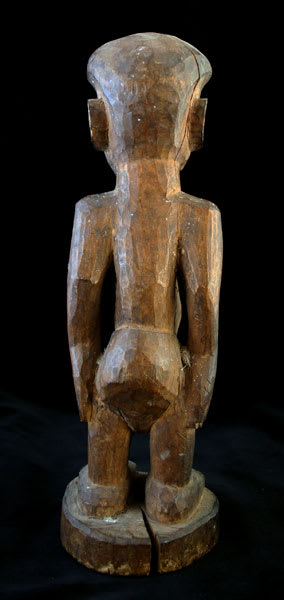Yoruba Wooden Sculpture of a Man, 20th Century CE
Wood
3.375 x 10.75
CK.0056
Further images
The Yoruba people, numbering over eighteen million, are one of the best known and most artistically prolific tribes of Sub-Saharan Africa. They are centered in southwestern Nigeria, with a significant...
The Yoruba people, numbering over eighteen million, are one of the best known and most artistically prolific tribes of Sub-Saharan Africa. They are centered in southwestern Nigeria, with a significant population extending into the neighboring Republic of Benin. In addition, many people in both North and South America claim Yoruban ancestry, a result of the Atlantic slave trade. Although Yoruban peoples have long referred to themselves by specific group names based on the towns they inhabit, they are all united by the Yoruba language, a common mythology, and related artistic styles, suggesting there is a common identity linking all the people. Historically, the Yoruba lived in politically centralized city-states, the most famous of which are Ife (the mythological nexus of creation), Owo, and Oyo (from which the name Yoruba was derived by missionaries). Yoruba art is now designated by the name of the geographic locale a particular group inhabited. Some individual artists and workshops have also been identified. The Yoruba are famed for their beadwork, which was used to decorate attributes of kings, including foot rests, crowns, and cloaks. Other major art forms include textiles, figurative implements used by herbalists and diviners, small figures carved to honor deceased twins (called ibeji dolls), cast copper-alloy ritual objects, as well as decorative stools and veranda posts that would have belonged to the king.
Stylistically, this figure is closely related to the ibeji doll type, both in terms of scale and form, specifically the upright stance with arms held along the sides. This piece depicts a man, naked save for the covering that shields his genital region. His facial features and almond-shapes eyes are characteristically Yoruba. This specific figure is closely related to another in our collection, item number SP.139, which depicts a female and was likely carved by the same sculptor, possibly as a pair. This couple might have once stood atop a family shrine, honoring the memories of ancestors past. Today, this charming sculpture symbolizes the outstanding artistry of the Yoruba peoples.
Stylistically, this figure is closely related to the ibeji doll type, both in terms of scale and form, specifically the upright stance with arms held along the sides. This piece depicts a man, naked save for the covering that shields his genital region. His facial features and almond-shapes eyes are characteristically Yoruba. This specific figure is closely related to another in our collection, item number SP.139, which depicts a female and was likely carved by the same sculptor, possibly as a pair. This couple might have once stood atop a family shrine, honoring the memories of ancestors past. Today, this charming sculpture symbolizes the outstanding artistry of the Yoruba peoples.









